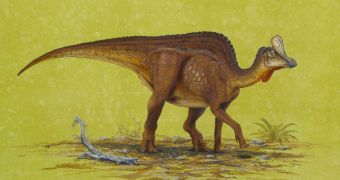72 millions year ago, the Mexican beaches were not roamed by tourists and mariachi, but by dinosaurs. One of them has been described in the "Journal of Vertebrate Paleontology": a large duck-billed veggie dinosaur with a sail-shaped crest. Velafrons coahuilensis lived just 7 million years before the dinosaur demise. This species witnessed the asteroid that wiped out the dinosaur world, as the impact took place in the Yucatan Peninsula of Mexico.
"Velafrons was probably a beach bum. Its shoreline home was lush, with rivers flowing into a warm, shallow sea," said palaeontologist Terry Gates of the Utah Museum of Natural History and University of Utah.
"It would have been a beautiful time to have been there - very warm, very Mediterranean-like. But you've got to worry about the tyrannosaurs out there. It is the most complete dinosaur ever discovered in Mexico. The discovery is helping open a window into life in the late Cretaceous Period on the southern tip of western North America," said Scott Sampson, a paleontologist at Utah Museum of Natural History.
The remains of Velafrons were discovered in a rugged, dry area of Coahuila (north-central Mexico). During the late Cretaceous, a large inland sea going from the Arctic Ocean to the Gulf of Mexico split North America in two. The new Dino had a hollow crest resembling the sail of a boat on the top of its skull, hence the name Velafrons coahuilensis ("sailed forehead from Coahuila"). Many duck-billed dinosaurs had this crest on the top of their head, crossed by long nasal passages.
"By lengthening its nasal passage, it allowed it to do all sorts of crazy things. It's totally odd and freakish," said Gates. The crests could have enabled these Dinos to emit trumpeted sounds (like in cranes and swans), aimed perhaps to attract mates. The young Velafrons was 9m (30 ft) long, but a full-grown adult could have been 10.7 m (35.7 ft) long. "Velafrons closely resembled another duck-billed dinosaur called Corythosaurus that lived roughly 3 million years earlier in Canada," said Sampson.
The same site contained the remains of small mammals, lizards, turtles and other dinosaurs.
"The remains of a horned dinosaur related to Triceratops were also found, as was evidence that a big meat-eater related to Tyrannosaurus was on the prowl. Many of the bones are covered with fossilized snails and clams, indicating these animals lived near the shore," said Sampson.

 14 DAY TRIAL //
14 DAY TRIAL //